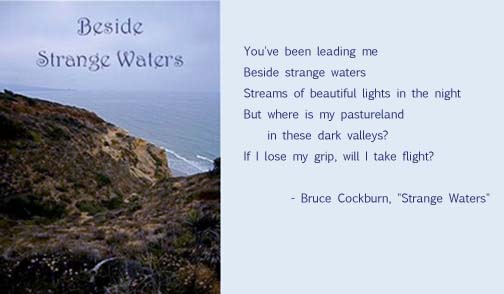Read through this passage a couple of times, and notice what Hetley does:
David gritted his teeth and followed Jo's hand through the darkness. He assumed the rest of her was still attached. Dark, clammy nothings brushed past his face and hissed in his ears. Phantoms teased the corners of his eyes, shapes black against black, yellow against yellow, flowing through the ghost images his brain played to give substance to emptiness.
The touches, sounds, and shapes plucked at his fear like virtuosi on overtaut harp strings. The air smelled of sodden graveyards, thick and rank in his nose and against his skin as if he had to swim through it.
Under the Sidhe hill, he thought. Three steps between magic and reality. Magic with teeth and claws as long as his forearm, magic that Jo carried in her genes.
He felt cold sweat between his shoulder blades and trickling down his sides under his arms. This was taking far too long.
Let's take a writerly look at what Hetley's done.
- DON'T BEGIN AT THE BEGINNING. Hetley starts in media res - in the middle of the action. We 're off and running from the first sentence. Or, in this case, immediately slogging through a terrifying world which shouldn't exist.
- INCLUDE A QUICK INTRODUCTION TO THE SETTING. With just a few sentences, Hetley sketches a horrific world of darkness, vile smells, and dangerous magic. By the third short paragraph, we already know that we are somewhere between our world and the realm of Celtic magic, and we also know that the fae in this world are not going to be nice.
- INTRODUCE THE READER TO THE CHARACTER(S). I love the sentence, "He assumed the rest of her was still attached" [i.e., Jo's body is still attached to her hand]. This tells us something about David's character, that he has a sense of humor and is a bit of a "smart ass." I like him already, and want to find out more about him and this crazy situation.
- USE HUMOR AND SURPRISE TO KEEP THE READER AWAKE. "He assumed the rest of her was still attached" is both funny and unexpected. But it's like seasoning in a good tortilla soup - just enough to spice things up, but not too much.
- USE POETIC TECHNIQUES LIKE SIMILE AND METAPHOR. The second paragraph is a bit overwritten, but it turns out to be appropriate because David is a musician in a Celtic band, and a poet. Of course he thinks in similes. And the use of smell - the sense which evokes the most emotion - is a nice touch. We associate putrefaction, and graveyards, with scary bad stuff. I'm feelin' it.
- EMPLOY PHYSICAL CLUES TO REVEAL EMOTIONAL STATES. We know that David's stressed, because he's gritting his teeth - a nice variation of the old "show, don't tell" rule to let us know what a character's feeling without saying, "He was so scared!" Paragraph three: Hetley does it again: "He felt cold sweat between his shoulder blades and trickling down his sides under his arms." Yep, that's definitely pretty scared.
- GROUND THE READER IN BOTH PLACE AND TIME. Hetley uses a single phrase "under the Sidhe hill" to ground us in a particular reality. If you know Celtic myth, you know at least half of where we are and what we're dealing with. We'll find out about the "reality" part later. The time is some variation of now, our contemporary world, because the narrator says, "magic Jo carried in her genes," and we know that nobody talked about genes before the discovery of DNA. In the past, when people talked about genetics, they'd say "blood" instead of "genes."
- USE SPECIFIC LANGUAGE AND THE MOST EFFECTIVE WORDS to introduce us to the characters. The use of "Jo" instead of a full name like "Josephine" or a more feminine nickname like "Josie" tells us something about Jo, too: she's a no-nonsense, tough, modern girl. The fact that David knows what's in her genes means they've been together for a while, and since they're holding hands, you might guess (correctly) that they are lovers.
- GIVE YOUR READER CLUES ABOUT THE CHARACTERS' RELATIONSHIPS. Yet another application of "Show, don't tell." We've actually already learned a lot about Jo and David: she's got fairy blood; he (we can infer) does not. She's the leader; this is natural to her and alien to David. He's been through this before, and he didn't like the experience then.
- USE FORESHADOWING. Phantoms, graveyard, the Sidhe, "magic with teeth and claws as long as his forearm" - as a reader, I'm guessing that David's in for a wild ride, and I am eager to travel with him.
When I say carefully crafted, I mean it - this is the kind of writing that emerges through multiple revisions. Most likely, there will just be hints of it in the first draft, phrases and ideas the writer can build on, and lots of flotsam and jetsam to edit out.
If I were to write a sequel to something, Hetley's opening is how I'd want to my novel to begin. In media res, with a clear setting in time and place, and enough of an introduction to the characters to make me want to read on and get to know them better. But nothing heavy-handed, nothing clunky or out of place. He makes it all sound natural and easy.
Nice work, Mr. Hetley!

No comments:
Post a Comment